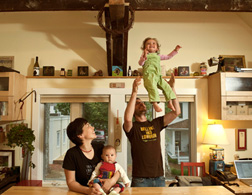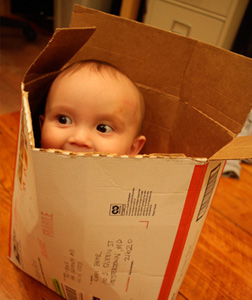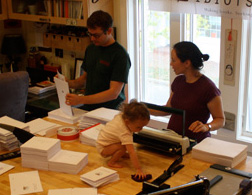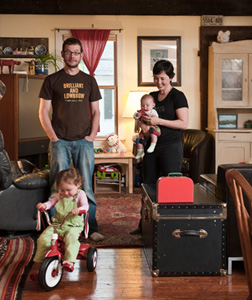Meet the Idiots
As part of the series on creative pairs, I'm subjecting a stellar writer/illustrator team—Matthew Swanson and Robbi Behr of Idiots'Books—to a series of experiments, stunts, and adventures. The goal is to shed light on the nature of their collaboration—and on the broader questions of relationships, psychology, and creativity.
To catch up on the series, check out " Two Is the Magic Number," the introduction, and " Two of Us," a three-part essay on the creative duel between John Lennon and Paul McCartney. To join the conversation, please comment below, tweet #creativepairs, join the creative pairs Facebook page, or follow the author on Twitter.
In the summer of 2006, Robbi Behr and Matthew Swanson quit their jobs at a high-end design and communications firm in Baltimore, sold their red-brick townhouse, collared their Weimaraner, and moved across the Chesapeake Bay to Chestertown, Md.—a town of 5,000 people where church bells ring on the hour, everyone knows everyone's business, and parking meters give you an hour's time for 25 cents.
This free fall into their partnership had a peculiar landing ground: the hay loft of a 19th-century barn they converted into a home and studio.
The barnstorming had been a long time coming—and represented the culmination of a journey that both Matthew and Robbi would come to describe as a salvation. After they graduated Williams College in 1997—they knew each other there but weren't close—Matthew got a job with the school's admissions office, while Robbi moved to Princeton, N.J., to work as a research assistant in the Department of Art and Archaeology, and to pursue a boyfriend who just wasn't that into her.
Matthew did well at work but began to languish elsewhere. He'd had star turns as a young actor, then as a singer-songwriter on the coffeehouse scene, and then as a blues harmonica player. But, in his early twenties, all he wanted to do was write these strange, dreamy sketches. They weren't poems, or serious fiction—"I don't really include character, plot, description," Matthew says, "some of those, you know, rather important conventions." He didn't know what to make of his work, let alone where to publish it.
There are few things worse than a creative itch you can't quite scratch, and Matthew was practically breaking into hives. He was also drinking too much, as in every night until he passed out. He preferred—he's embarrassed to say it now—40-ounce bottles of malt liquor.
One Sunday morning in the fall of 1998, Matthew woke up, got drunk, and, in a fit of guilt, pulled on his running shoes and headed out. He'd run the same route every day for a year, but, for some reason he can't now fathom, he went another way this day—and ran into Robbi, who had been on a weekend visit with her boyfriend.
Intense creative connections don't always strike like lightning. Sometimes, they grow like a culture in a petri dish. A few months later, Matthew not only met Robbi's family; he went with them to Bristol Bay in the Alaskan tundra where the Behrs spend their summer as commercial salmon fishers. For Matthew and Robbi, it took 10 months of fervent correspondence before they met up again in person and fell fully in love. Robbi soon moved back to Williamstown and they took a job as live-in caretakers for a man with severe mental and physical disabilities. In between feeding, teaching, and cleaning their friend David, Matthew began to show Robbi his work.
"You write a book," Gertrude Stein wrote in The Making of Americans, "and while you write it you are ashamed for every one must think you are a silly or a crazy one and yet you write it and you are ashamed, you know you will be laughed at or pitied by every one and you have a queer feeling and you are not very certain and you go on writing. Then someone says yes to it. …"
Robbi's "yes" moved in two directions. She didn't just appreciate Matthew's writing. She also felt drawn to work with it herself. Illustrators usually represent in image what's already articulated in words. But with the huge spaces in Matthew's work, Robbi felt an opening to both follow and lead—to punctuate the text and to carry it along like a schoolmarm bending a little boy's ear. The two found themselves hashing out the ideas in Matthew's pieces—and how to compound, contradict, and enrich them. "It was the most thrilling artistic thing that had ever happened to me," Matthew says. "It was like the first time I took a drink. It was this visceral gut-wrenching thrill of being in a new time and place. It was, 'Oh my god, this is something I can do.' "
From not knowing what to call his writing, Matthew and Robbi went to not knowing what to call their collaborative creations. A handful of times, Robbi scanned her images, laid them out with Matthew's text, and stitched handmade books with printouts from her Epson inkjet.
But for years, the collaboration was a sideline, a footnote on the blank pages of their career. Both looked for something real to do—teaching school, maybe, or social work. Robbi got her master's from the Savannah College of Art and Design. Matthew tried for a while to write "serious" fiction and apply to MFA programs himself. "I applied to six schools and got seven rejections," Matthew says. "The University of Minnesota rejected me on two consecutive Mondays—with letters signed by the same person."
When they ended up in Baltimore, it looked to all their friends like they were the classic upwardly mobile hipster professionals. "We even had the designer dog," Matthew says. He kept a good front—even to himself—and it was really only Robbi who could see how near he was to collapse with anxiety and ennui. That's when she floated a radical idea—that they should ditch it all, move to her parents' barn, make books together, live on freelance gigs, and come what may.
Robbi grew up in Chestertown, on North Queen Street, and her mother keeps a pottery studio in an old barn about a block away, on South Queen. Upstairs, Robbi's father had a corner for his workroom and hideaway; the rest was a storage for ikebana pots, clay, scrap metal, packing popcorn, PVC pipes, and an old foosball table—things like that. Taking over the space was no small feat. After 30 van trips to haul away the junk and sell everything else at auction, they had to caulk the drafty pine walls; attach tar paper, insulation, and sheetrock; erect walls, run electrical lines, and finish the floor. Even then the Idiots had no air conditioner in a place where summer temperatures reach into the high 90s. They had only a hot plate to cook with and washed their dishes in the utility sink in the studio downstairs.
This Spartan life fit with the mission—to leave the world behind, both physically and symbolically, and make their art the center of everything. They came with a menagerie of creatures—Iggy the Weimaraner; Oscar and Lily, the improbably fluffy cats—one orange, the other jet black—and a tank full of fish. Even their furniture had life, like the lamps made from found objects—a parking meter, a fire extinguisher, a gumball machine—by their friend Maggie Adler. (Inspired by Maggie, the Idiots even wired up an old hairdresser's dryer.)
Spaces both reflect and create our identities. This is intensely true of Matthew and Robbi, not only because their home is so peculiar—and because coming to it represented a leap into their partnership—but also because they rarely leave. I know Matthew and Robbi because, right around the time they moved to Chestertown, I took a job there directing a literary center at Washington College. One night, I suggested we meet at Andy's, a town institution (now late and lamented) with a big bar and great comfort food. In this small town, Andy's was like the diner in Seinfeld, the default gathering place. It's also about two blocks from the barn. It turned out that Matthew and Robbi had never been in the door. Matthew wasn't even sure where Andy's was. "The barn is our whole world," Matthew says. "Andy's is two blocks away, but it might as well be 2 miles—or 200—because it's not in here."
For the games they play together, the barn is their clubhouse. In the storybook of their lives, it's like the giant peach, or the old lady's shoe. But it's also, literally, a workshop—a place where Matthew and Robbi print and bind books that they send out to subscribers six times a year. Their books always end with a cheeky bio for both Matthew and Robbi, followed by the phrase: "They live in a barn in Chestertown, Maryland." Two is the magic number, but the barn is their third—the space that holds their relationship.
The premise that space meshes with character is more than intuition. The psychologist Sam Gosling has combed through homes—noting everything from the clutter on desks to the orientation of photographs to the music on CD shelves—and found that three of the "Big Five" personality characteristics—conscientiousness, openness, and extraversion—can be accurately predicted by the home visit, when compared with self-reports, accounts from friends, and a battery of psychological tests.
Gosling's protocol wasn't exactly right for this gambit, because I wasn't looking to classify Matthew or Robbi, but to learn from the barn how they relate to each other and work together. For that, I needed something more intuitive, more expansive than experimental psychology.
So I turned to feng shui, the ancient Chinese art at the intersection of physical space and human experience. I found the perfect partner in Catherine Brophy, "The Feng Shui Detective." A former stage actress who studied the tradition with one of its Western masters, she has a highly regarded practice based in New York City, with work featured in the New York Times, Domino magazine, and AtHome.
We came to Chestertown on a grim, cold February day. Hearing about "the barn" and seeing an image Robbi drew for their blog The Barnstorming (now moved to idiotsbooks.com)—Catherine brought hiking boots. She figured she'd be tramping around in the snow. She was surprised, then, to see the barn on a residential block—a gray and red building surrounded by traditional Victorians.
We parked on South Queen Street and I called Matthew and Robbi on my cell phone. They came to greet us at the door to a small gallery that fronts Seiko Behr's pottery studio. Once inside the gallery, we slipped through a door that most visitors would probably miss; it leads to a spiral staircase into Matthew and Robbi's bedroom/studio.
Matthew is thin, usually bearded or goateed, and wears plastic rectangular glasses. He has a big smile and a stock of T-shirts that remind me of the hats worn by Frank on 30 Rock, always a new one but always the same odd tone. Today he wore the one that shows a hot dog giving a bottle of mustard an enthusiastic high five. Robbi is shorter—she comes to about Matthew's ear—and has the pretty, buoyant look that fits the daughter of a dainty Japanese mother and a ruddy American father. She had on a white cable-knit sweater and blue pants. They both wore slippers.
Matthew and Robbi showed us around and gave us the history. In the spring of 2008, with their baby girl Alden just home from the hospital, they built a proper kitchen and took over a portion of the loft they'd originally carved out for continued storage. They turned their bedroom into a nursery and built a bedroom and studio for themselves in the extension. (Just before our visit, they had their second child, a boy named Kato, pronounced Kahto, named for a Japanese samurai ancestor.)
After a quick tour, Catherine asked to see the front door. Feng shui proceeds from that point, she explained, to locate the basic regions of the space (career, finances—or heavenly blessings—health and family, knowledge, reputation, relationship, children and creativity, friends and travel).
You would think that finding the front door would be simple, but in Idiotsland it turned out to be complicated indeed. We'd taken the most direct entry into the space, but it was hardly a front door—it's obscure and, anyway, you'd need to be inside the barn to access it. We also could have come in through Seiko Behr's studio and up some old wooden stairs in the back. At the top, there's a proper, bright red door you can knock on—except Matthew and Robbi's space actually begins before the door; their old bedroom, now the kids' room, hangs off to the right. Finally, there's a back door to the barn. It leads through a storage space next to the kiln, to the same stairs.
"I've never been in a space with no obvious front door," Catherine said. She was also surprised by the open layout—no man cave, no woman's nook. Even the bedroom has an open passage and barely space enough for a queen mattress and two side tables (Matthew's is an old milk dispenser from a school cafeteria.) "There's literally no place for them to be here, except together," Catherine said.
By contrast to the squeezed-in bedroom, the studio has been given the maximum square footage and light. It's their work, the Idiots say, that occupies not only their intellectual and creative attention—but even much of their erotic drive.
The porousness is literal. The studio space is next to the bedroom—but the only division is a wall that rises about chest high. If you wanted a setting for a children's book where dreams float from a sleepyhead into piece of writing or drawing, this studio would be the perfect setting—from the bed, there's a clear shot for a dream to sail into the notebooks, Apple computers, sketchbooks, easels, printers, binders, hole-punches, and everything else that makes Idiots'Books go.
The studio space itself was also telling. Matthew and Robbi each have L-shaped desks on opposite walls, but a large worktable dominates the room. As they described their process to Catherine, it became clear just how much happens in that mutual space.
The simple way to describe Matthew and Robbi's collaboration is that he is the writer, and she is the illustrator. But the working exchange is much more intricate. He initiates the work—he writes and generates pieces constantly—and she chooses what she wants to illustrate. Then they hash out all the questions, from the aesthetic (what will it look and feel like?) to the spiritual and intellectual (what is it about?) to the practical (how will it be made, on what kind of paper, in what size, and at what cost to print, bind, and mail). When this is done, Matthew moves into the role of art director—keeping his eye on deadlines—then Robbi steps in again to serve as production manager, working out the details of actually getting the thing made.
But the connection isn't just a series of discrete exchanges. The relationship is like an old tree that has large, knobby roots poking out and cracking the sidewalk. There's a lot of life to see. But there's a whole world underground.
We got a peek into the depths in a surprising way. Robbi and Matthew's desks look pretty much identical. But Catherine pointed out that Robbi's desk chair faces the wall, 180 degrees from Matthew, while his seat is arranged 90 degrees from her, so she's just a glance away and always in his periphery.
"My main problem," Matthew says, "is leaving Robbi alone." Where he's always buzzing with ideas—writing in bursts, devising new projects (and working a half-time consulting job that pays their bills)—Robbi can really only focus on one thing. She putters, meanders, and frets and then, suddenly, falls into the work as though through a trapdoor, keeping at it for six or eight, sometimes 12, hours without a break. As much as Matthew's deadline mongering injects energy into their work, and as much as they develop their ideas together, there always comes a point when she has to make him go away. Literally. During one big project, she put him on a plane to his father's house in Kansas City.
Matthew understands, but he doesn't like it. That's why, at home, he arranged his seat so that she would never be out of view.
"What do you suppose that's really about?" the Detective asked.
Matthew answered with a story. In the middle of their 2006 barn reclamation, it came time for the Behrs to go fish in Alaska. Matthew stayed behind to work. But just a few days after Robbi left, he fell apart and began to drink again. He'd been sober for six years. His father came for a visit and, over a diner breakfast, Matthew began to sob uncontrollably. "I just lost it," he says. "I had lost my way."
When the July 4 weekend came, with his father gone, Matthew faced three full days alone. He knew he'd have only one thing on his mind—that his attention would point to the beer aisles at the supermarket like a magnet points north. So he came back to the barn and began to insulate.
Hanging insulation is usually a two-man job—one props up the heavy batons of insulation, the other staples it in place. "I would put the baton on my head," Matthew said, "crawl up the ladder with it draped over me on either side, steady it with one hand, and staple a piece to the beam with the other hand." Then he crawled down the ladder, moved it a few feet, and did it again. His dust-masks turned black. It was about 90 degrees outside, and 105 degrees inside the barn. Over the weekend, he insulated every surface in the 20-by-40-foot space, with 13-foot ceilings.
Just as the temptation to drink tugged him back to chaos and self-destruction, Matthew's vision of the barn—and his life with Robbi—drove him forward. "It was like my vision quest," he says. "The space became a metaphor. It was like my temple."
Matthew's story of their relationship, and partnership, is nothing less than a salvation narrative. "If I hadn't met her," he says, " I would be fat with liver failure and a disease, by the side of the road in Massachusetts with a bottle of something in my hand."
This kind of veneration can be hard to take. It's no wonder that Robbi, despite her obvious and unrelenting warmth for Matthew, still spends her days protected from his gaze.
But, in her own way, Robbi joins him. If they hadn't met, she says, she'd probably be married and content but rarely making art. "I saved him from an awful fate," Robbi says, "and he saved me from boredom."
The intensity of the bond is pretty staggering—and we kept coming back to that point, especially because—after almost 24 hours in Chestertown—the Feng Shui Detective still couldn't identify the front door.
And it occurred to me, in all the years I lived down the road from Matthew and Robbi—their closest friend in this small town—I never once dropped by. I might pass by the barn, and glance up at the windows to see if a light was on, but even these few feet away, the space was as hard to reach as the Bat Cave.
And that reminded me of the few occasions when I came into conflict with the Idiots. When I directed the Lit House at Washington College, we did a fair amount of work together, and I usually loved their ideas. Often, when I pushed back, they agreed quickly to show me something new or to revise. Other times, they would rise up at me together and I would fold as quickly as a beach chair in a fierce wind. In both cases, their unity was complete. My relationship wasn't to either one of them alone, but to them as a unit.
Catherine and I felt it too. For all the life we felt inside the barn, it was very clear we were guests who had been invited into the anterior. In their relationship, as with the barn, no one really gets in the door but them.
This, then, was the final task. To try to at least peek through the door—to get a glimpse, at least, of the relationship's real secrets. Tune in for part three.
Do you have a test or experiment to throw at the Idiots? Tell us below, or come onto the Creative Pairs Facebook page.
Like Slate on Facebook. Follow us on Twitter.



